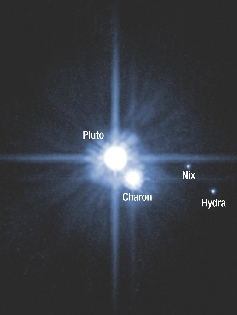Icy Objects–Dwarf Planets and Comets
Pluto used to be considered the ninth planet in our solar system—but this has changed. Scientists have decided that Pluto is not a planet because it is too small. Pluto is now called a dwarf planet.
Pluto is not rocky, like Earth is, and it is not made of gas like Saturn. Pluto has a small, rocky center that is covered with ice. It is like a giant snowball in space. Pluto is farther from the sun than Neptune. It takes Pluto more than 248 years to travel once around the sun.
Pluto is not the only icy object that moves around the sun. Comets do, too. Comets are large chunks of ice, gas, dust, and rock.
Comets are found far from the sun most of the time. When a comet gets close to the sun, the ice on its surface becomes gas. The gas forms an atmosphere, called a coma, around the comet. Some of the gas is pushed from the comet into space, and this gas forms the tail of the comet.

This image shows Pluto and its moons—Charon, Nix, and Hydra.